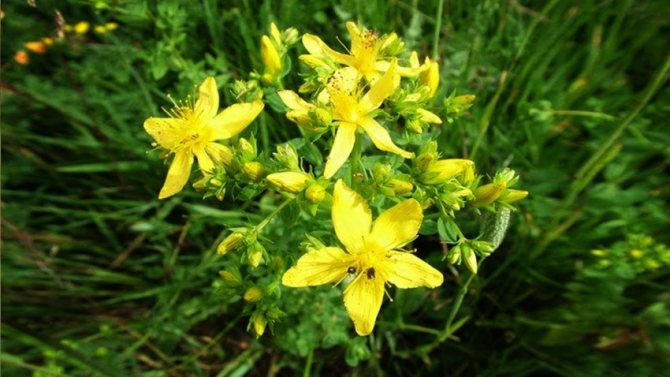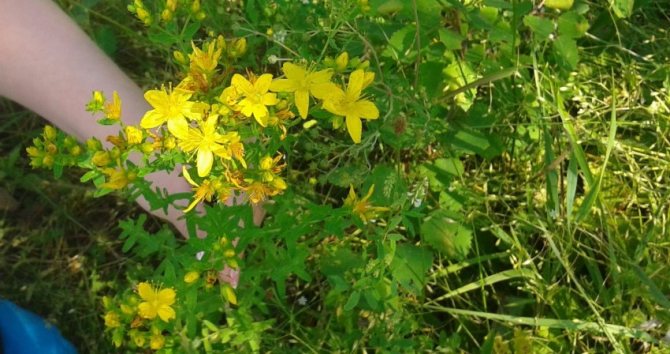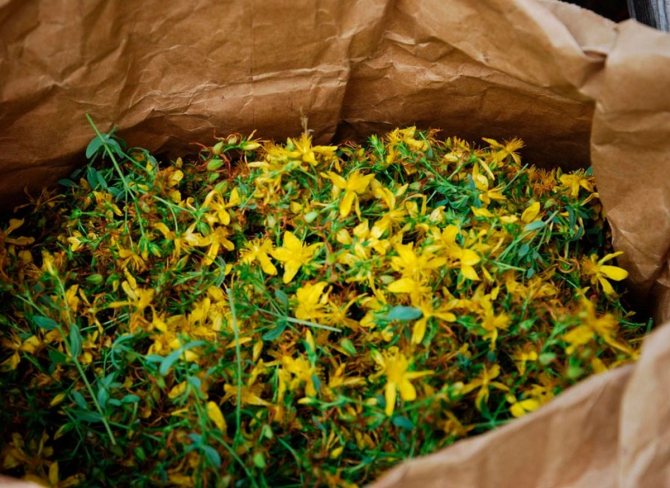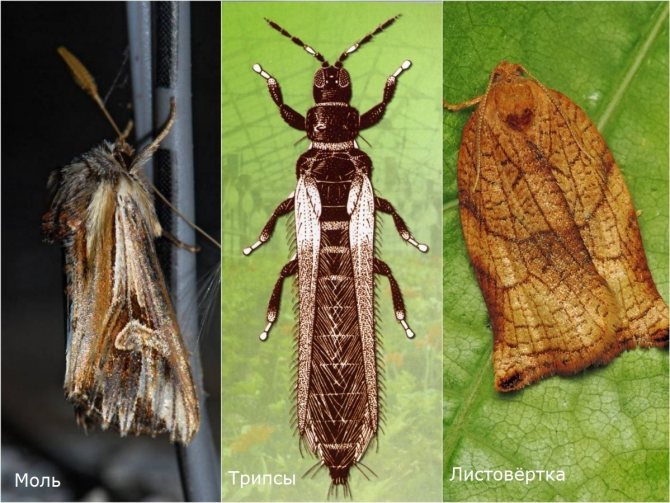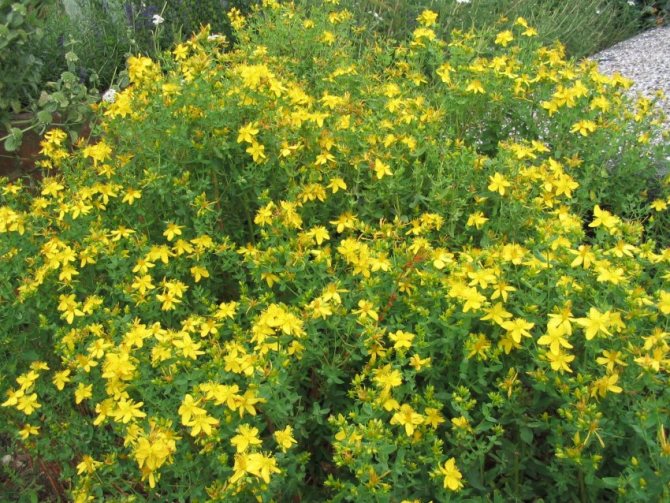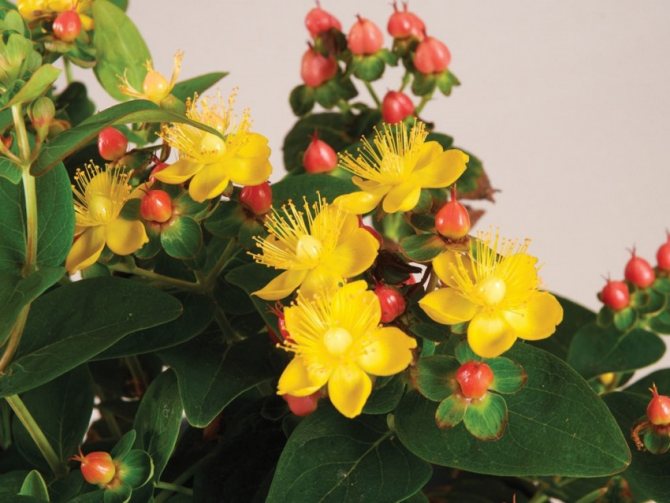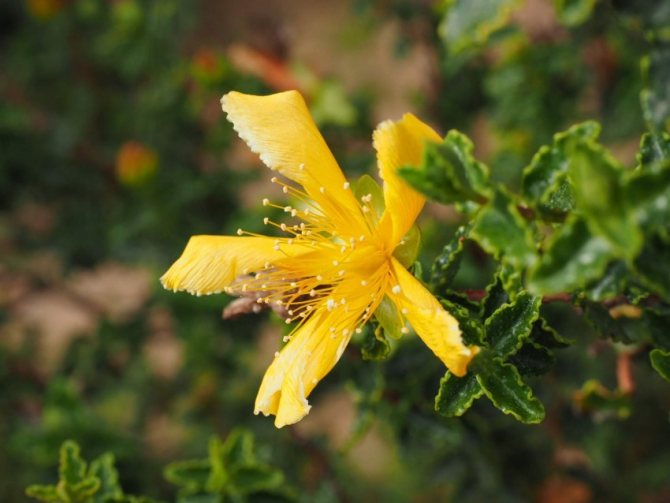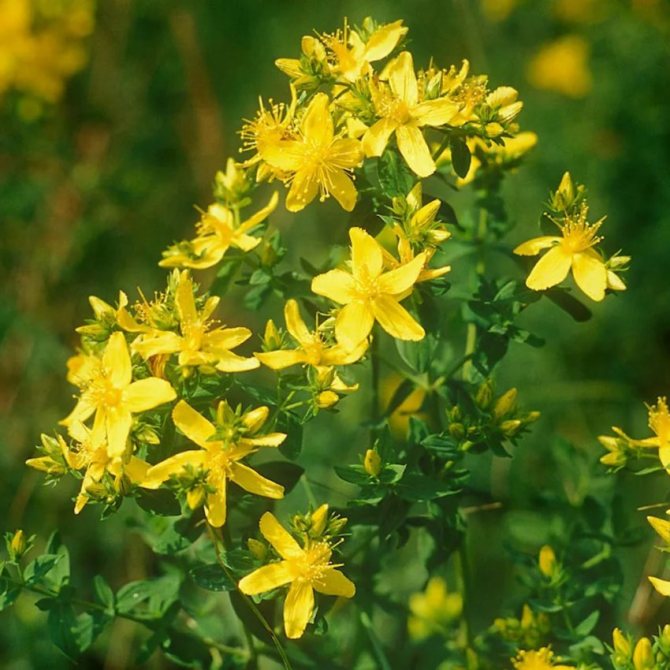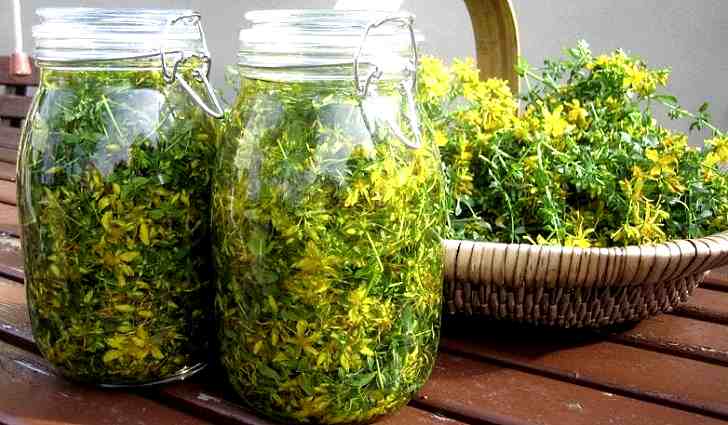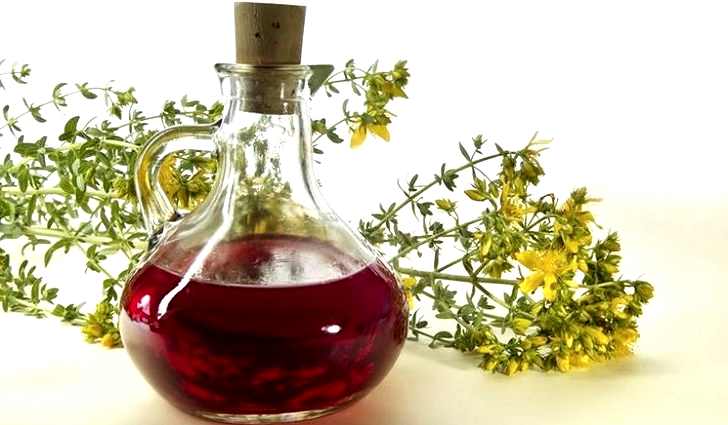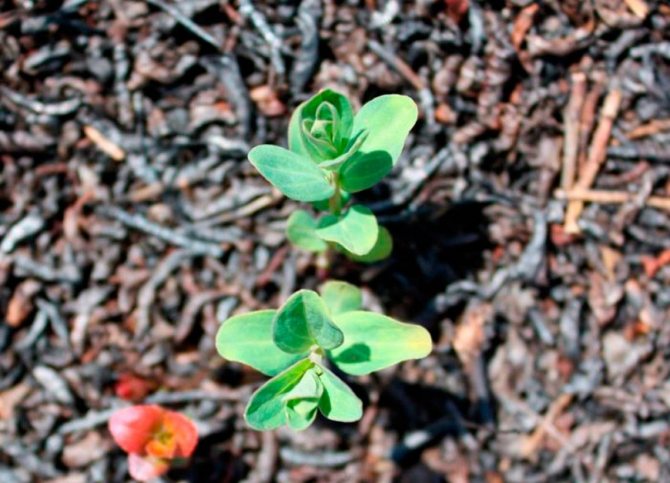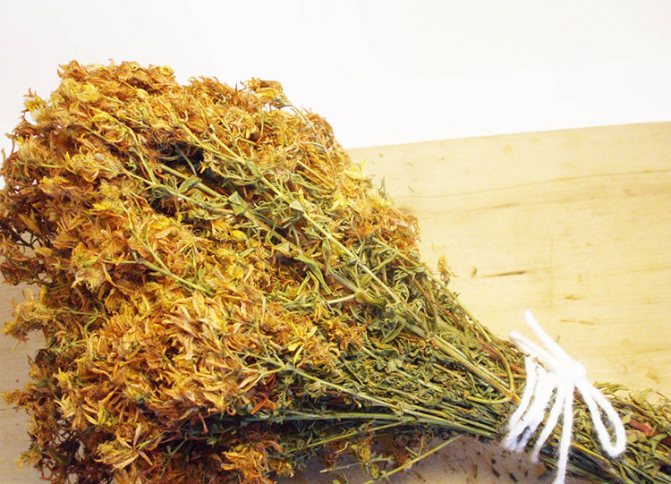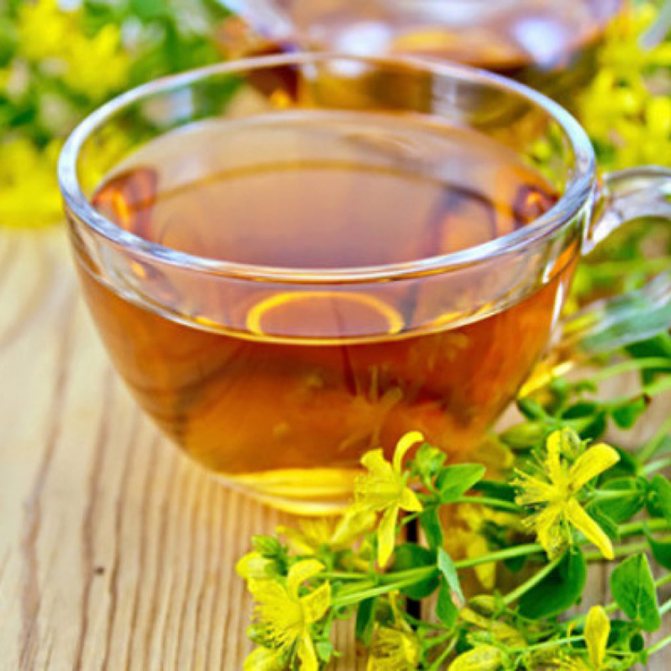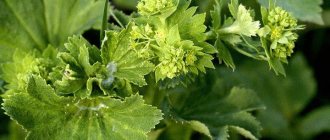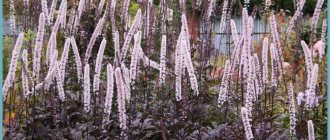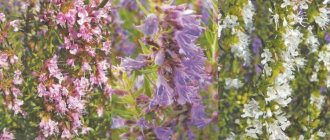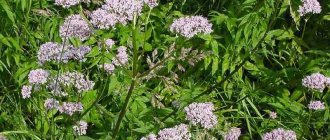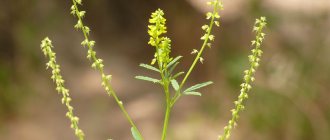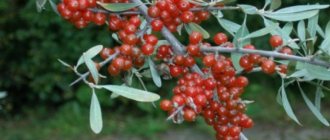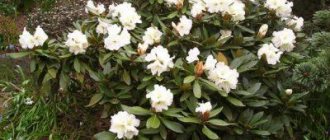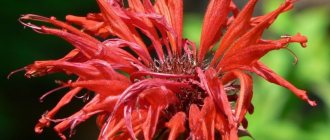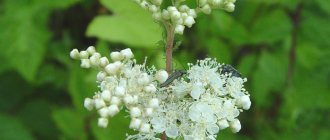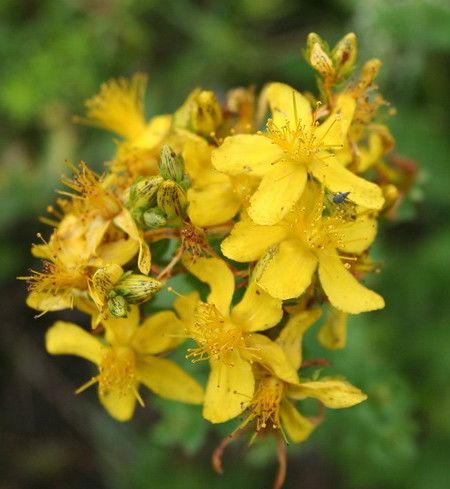
St. John's wort (Latin Hypericum perforatum) - This is a perennial herbaceous medicinal plant of the family of St. John's wort (others, including popular names; St. John's wort (hypericaceae), St. John's wort, hare's wort, bloodthirsty, ailment).
Distinctive features and characteristics:
stems - a bunch of several pieces, less often one, erect, rigid, smooth, cylindrical, from 30 to 100 cm high;
leaves - paired, sessile, oblong-oval with small glands located longitudinally along the leaf, translucent in the light, hence the name - St. John's wort;
flowers - five-petal, regular shape, yellow-golden, collected in spherical-paniculate inflorescences,
stamens are numerous, accrete in 3 bundles, sepals are pointed, covered with dark glands, sepals along the edge are even or slightly toothed;
fruits - leathery capsules with numerous seeds, rusty color.
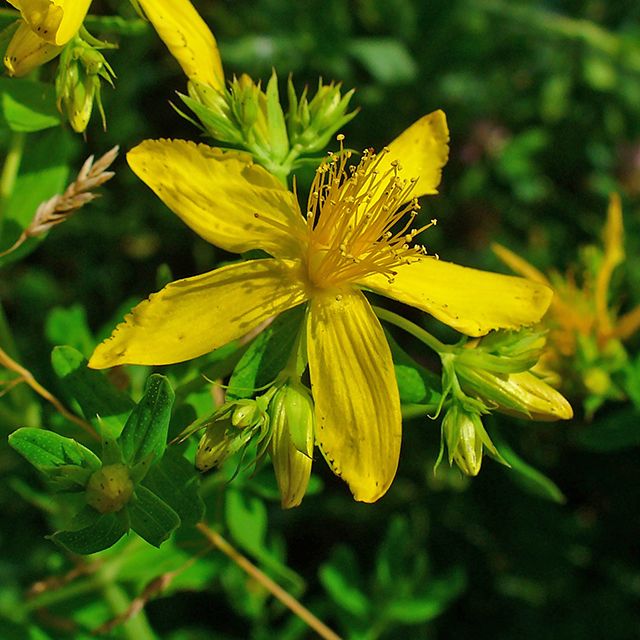

Blooms June to August; fruits ripen in September - October.
St. John's wort is distributed everywhere except in the northern regions; grows in forest meadows and forest edges, in sparse forests and among bushes.
Plant photos
St. John's wort (see photo) has different varieties, which differ from each other in appearance.
Hypericum perforatum
St. John's wort has other names:
- ivanovskaya grass;
- Ivan's blood;
- bloody;
- ailment;
- healthy grass;
- Duravets;
- blood herb;
- hard hay;
- the grass of Jesus wounds;
- wound grass;
- raven;
- holy potion;
- tears of the mother of God;
- good blood.
The herb is used as follows: it is harvested during flowering and then harvested. For this purpose, flowering tops with leaves are suitable. After collection, they must be dried. The plant is a good antidepressant: it normalizes sleep and improves mood.
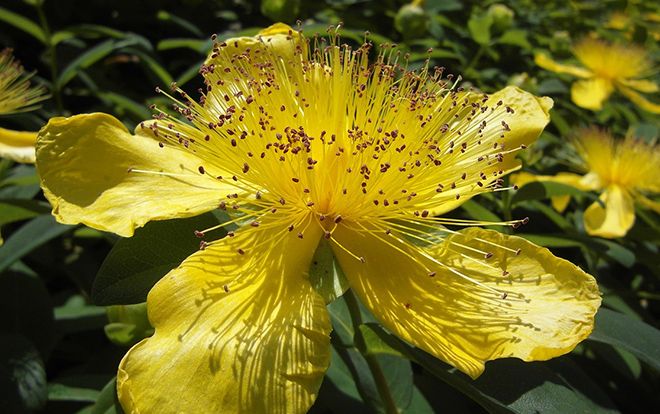

It has many beneficial properties:
- anti-inflammatory;
- pain reliever;
- antispasmodic;
- antiseptic;
- treats arthritis;
- stimulates tissue regeneration.
It is recommended to use it when:
- neuroses;
- insomnia;
- headaches;
- diseases of the gastrointestinal tract;
- kidney disease (as a diuretic);
- cardiovascular pathologies (myocarditis and endocarditis).
Doctors recommend rinsing the mouth for stomatitis and gingivitis to strengthen the gums. In addition, the tincture is used in the treatment of diabetes mellitus, erosions and ulcers on the mucous membranes and skin.
According to the studies, the extract of this plant helps to strengthen the immune system, sobering up during acute alcoholic intoxication.
When taking medications based on this plant, side effects such as pain in the liver, bitterness in the mouth, decreased appetite, and constipation may occur.
It must be borne in mind that St. John's wort increases systolic pressure, and therefore doctors advise patients with arterial hypertension to use it exclusively as part of herbal preparations.
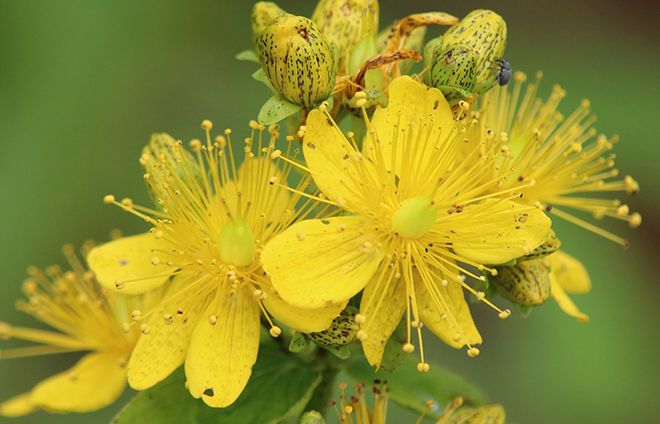

St. John's wort
St. John's wort possesses not only useful properties, but also decorative qualities.It is a lush bush adorned with small yellow blossoms. Its healing properties are used in traditional and folk medicine. It has a wound healing, vitaminizing, anti-inflammatory and antibacterial effect.
St. John's wort is unpretentious, it can be grown on any land plots. An important condition is to sow the seeds at the right time for this.
This species is highly branched. The bush can reach a height of 0.7 m. It is characterized by small leaves (up to 3 cm in length), which densely cover the shoots, which gives the bush a lush and delicate look. It can be planted both in a summer cottage and in a flower bed. It is undemanding to care for, resistant to cold and drought.
St. John's wort
Prone to strong branching, due to which the plant forms a lush crown. Leaves of an ovoid (oval) shape are located on the stem opposite each other and are distinguished by a solid edge. Different varieties of this plant can have leaves from 1 to 10 cm long. The height of the stem, regardless of the variety, does not exceed 1 m.
Flowering is accompanied by the appearance of bright yellow flowers. They can be of different sizes, but they always grow densely and in large numbers. In the middle of the inflorescence of shrub St. John's wort there are many long stamens, which gives it a decorative effect.
St. John's wort blooms in early summer. Its significant advantage is its long flowering period - 1-2 months. The fruits ripen in early September and are a 3-sided box with many small seeds inside.
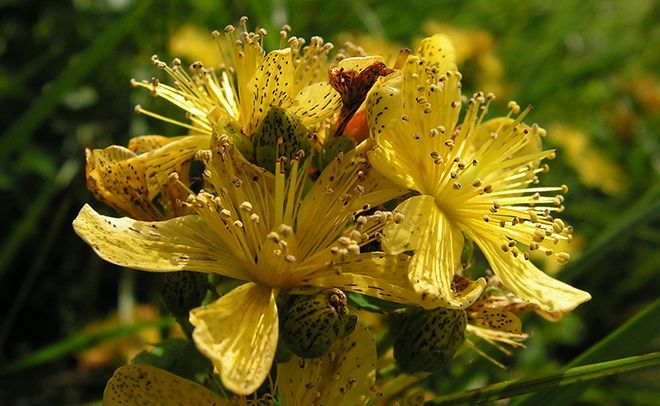

In folk medicine, St. John's wort is more popular due to its healing qualities. Despite this, many varieties of shrubby St. John's wort can be useful in the treatment of certain diseases, since they contain phytoncides, flavonoids, tannins, micro and macro elements, vitamins, etc.
Read also Amaranth vegetable seeds buy
Photo of flowers St. John's wort
The flowers of this medicinal plant represent a wide panicle in the form of a shield. The cup contains 5 lanceolate leaves in the shape of a cup. The corolla consists of 5 yellowish-orange petals. Purple and black-brown specks can be seen on the surface of the petals, especially on the edge. The stamens grow together at the base and form 3 bundles. The flowering period of the plant is July-August.
Photo of dried St. John's wort
The herb and flowers of this plant can be used dried as seasonings for various dishes (in particular, fish). In addition, they are added to various drinks to give them a spicy aroma, bitter-tart and balsamic aftertaste.
Collection and drying
When assembling, you need to cut off the tops of flowering stems 15..30 cm long, along with leaves and flowers. John's wort must not be loosened and uprooted - this leads to a rapid depletion of the natural resources of the valuable plant. Very large stems must be left in order to resume the harvest. The collected grass is tied in bunches and hung to dry in attics or spread in a thin layer on a paper-grass mat and dried in a well-ventilated area. When using heat dryers, the temperature should not exceed 40 ° C.
Flowers when properly dried should retain their bright yellow color, stems and leaves matte green. The taste of dried St. John's wort is bitter-resinous; water-soluble substances, which then pass into infusions and teas. Dried herb retains its medicinal properties for at least three years.
What is the healing power of St. John's wort.
Studies of the composition of the plant have shown that it contains up to 55 mg% carotene, 50 mg% vitamin C, P-active flavonoids, nicotinic acid, vitamin PP, essential oils, saponins and other substances.
Unique properties of St. John's wort
St. John's wort plant (see.photo) has such unique properties:
- astringent;
- hemostatic;
- anti-inflammatory;
- pain relievers;
- antiseptic;
- wound healing;
- diuretic;
- choleretic
Enhances appetite, helps to normalize the endocrine system and regenerate tissues and organs, soothes the nervous system.
On the basis of research, it was found that the plant reduces capillary permeability, triggers recovery processes in the body, has a fortified composition, etc.
St. John's wort tincture is prescribed for diseases of the female reproductive system, gastrointestinal tract (colitis, diarrhea, etc.), spasms and pain syndrome of the stomach and intestines, liver, kidney (kidney stones), cardiovascular diseases, urinary disorders (cystitis, urinary incontinence in children, etc.).
It is prescribed by doctors for stress and nervous breakdowns as a sedative. In addition, it has a strong analgesic effect, has an antihelminthic and disinfectant effect.


In German folk medicine, an infusion of this plant is used for such diseases:
- dropsy;
- rheumatism;
- hemorrhoids;
- diseases of the gastrointestinal tract;
- liver and kidney diseases;
- headache;
- irritability;
- sleep disorders;
- nervous convulsions.
For rheumatism, it is recommended to use a tincture of alcohol in the form of drops. You can also apply rubbing for sore joints using a tincture of chopped herbs with the addition of vegetable oil and turpentine.
To make the wound heal faster, it is necessary to attach the crushed leaves of a fresh plant to it.
To rinse the mouth, dilute the alcoholic tincture with water. This procedure helps to get rid of bad breath. It is recommended to treat the gums with undiluted tincture for strengthening.
In dental practice, St. John's wort oil is used to treat subacute and chronic stomatitis and gingivitis. It has unique healing properties, and the presence of vitamins A and C in it enhances the therapeutic effect.
This medicinal plant is used in many medicinal preparations: diuretic, antirheumatic, astringent.
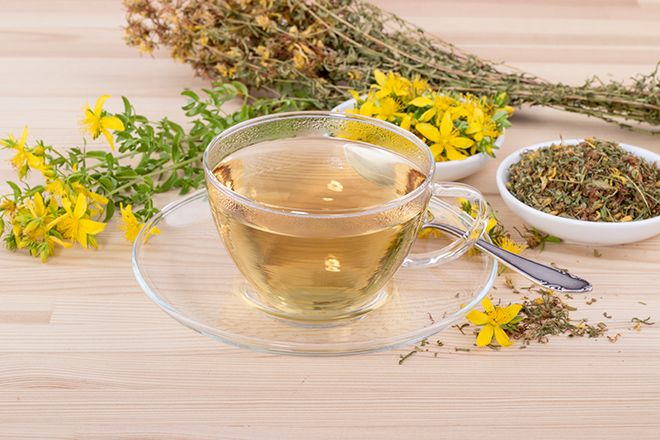

Scientific studies have proven the effectiveness of ethereal-alcoholic extract of St. John's wort in chronic and acute colitis.
Not so long ago, a new remedy based on St. John's wort was released - Imanin. It is intended for external use and is used for burns (prevents the formation of scars), skin diseases, fresh wounds, boils, ulcers, inflammatory and purulent processes on the surface of the skin, acute respiratory infections (acute rhinitis stops within 2-3 hours after taking this drug).
St. John's wort has not only medicinal properties, but also contraindications for use. Ingestion of a fresh plant must be carried out with caution, since it contains some toxic substances in its composition. Despite the low toxicity, with frequent use, it can cause the following side reactions:
- bitterness in the mouth;
- heaviness in the right hypochondrium (in the liver);
- violation of bile secretion, etc.
It should not be taken by pregnant women as there is a high likelihood of miscarriage. It is also forbidden to use those who have undergone organ transplant surgery, because St. John's wort can contribute to its rejection.
In addition, it enhances the effect of sunlight on the skin, therefore, after drinking tea with St. John's wort, it is not recommended to sunbathe under the scorching sun in order to avoid severe burns.
This herb can significantly reduce the effects of contraceptives and should be used with caution.
Olympic
Its homeland is considered the European countries of the Mediterranean and Turkey. In height, the Olympic St. John's wort reaches 35 cm, and the diameter of the bush is about 25 cm. Its rhizome is quite strong, but not deep.
The leaves are elliptical, greenish-gray.It blooms with large yellow flowers up to 6 cm in diameter, which are collected in apical semi-umbrellas. Flowering falls in late July or early August, in greenhouses and flower beds, it begins to bloom three years after planting.
The plant is freely propagated both by seed and by dividing the roots. It does not need transplants for decorative cultivation. It is undemanding in relation to the soil, but loams are considered the best option for its good growth.
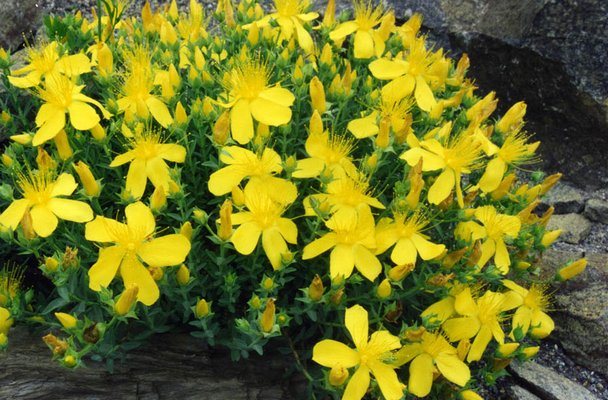

As for lighting, it should be in an open, sunny place, if you plant it in the shade, then the likelihood that it will bloom will be very small. It does not need frequent watering, it does not tolerate stagnant water well. St. John's wort is often used for landscaping cities.
Pictures and drawings of plants
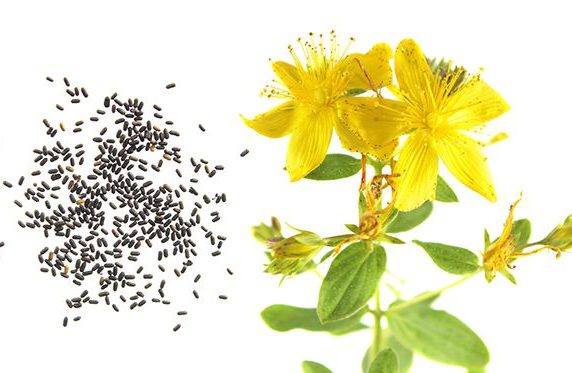

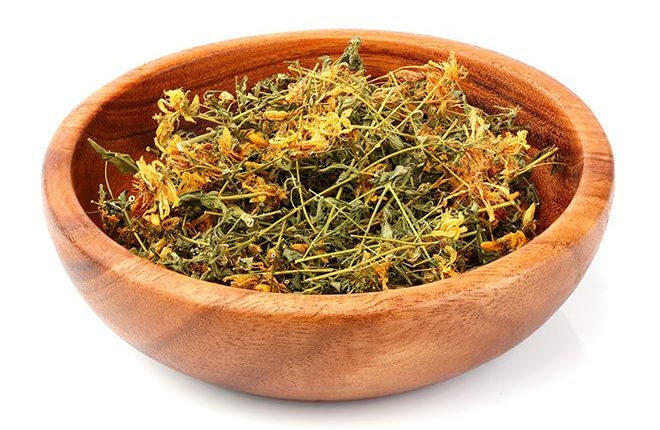

- Origin
The plant St. John's wort (hypericum) is a perennial shrub. St. John's wort also has other names: Young blood, Ivanovo grass, ailment. It has long been believed that St. John's wort was due to the feather of a bird that fell rapidly from heaven due to being wounded by the enemy. Later, the plant was assigned the function of expelling evil spirits. Since the juice of St. John's wort has an unusual purple color, it was considered unique, with enchanting properties.Origin: mountainous regions of Asia Minor.
Tetrahedral (four-winged)
St. John's wort is very similar to the common one. It can be distinguished from an ordinary one by four longitudinal sharp ribs on the stem, while the ordinary stem is cylindrical with two grooves.
Sepals do not have yellowish cilia at the edges. Black dots can be found on the flower petals.
Distributed in Eastern Europe and Asia. It is not recommended to use it for medical purposes due to its high content of toxic substances.
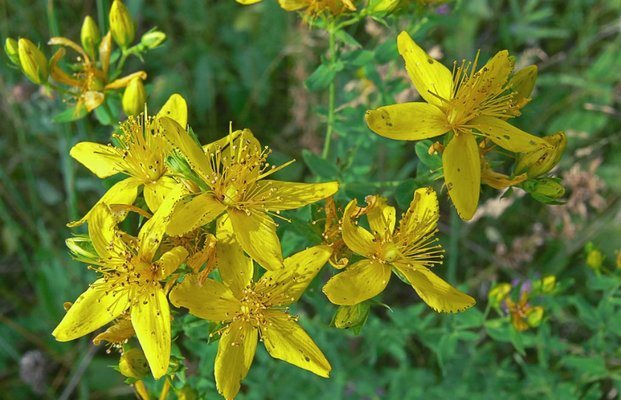

Growing St. John's wort at home
St. John's wort can be grown at home. The plant within the framework of the house is more demanding, therefore, several important rules must be observed, otherwise the plant will wither and shed its leaves, because after all it is a street plant.
Household St. John's wort needs a lot of sunlight. A balcony or a room with a well-lit windowsill is suitable for this purpose. In case of insufficient natural light, you need to supplement it with the use of artificial light. Without sufficient lighting, the plant will bloom less abundantly, if the daylight hours are too short, it may even die.
At home, during the winter, it is necessary to prune the shoots with St. John's wort in order for new ones to grow.
The temperature of the content should be medium, about 17 - 20. In the summer, there should be humid air in the room with the plant. If the air is dry.
Give the plant a daily shower. In winter, the plant needs coolness; for these purposes, you can install an air conditioner in the room.
Watering should be regular, but watch the roots of the plant, it is very important not to overflow, otherwise the root system will start to rot. It is not worth overdrying the plant, as this will affect the flowering of St. John's wort. The plant is usually transplanted every 3 years, preferably in the spring. The plant tolerates a transplant to a new place of residence perfectly.
Plant in the pot
Cold preparation and winter hardiness
Shrub St. John's wort is characterized by low cold resistance, so the plant must be covered for the winter. Shoots that are not covered with snow and are not wrapped up die in winter. They can survive only in regions with relatively mild winters - in the Caucasus, in Western European countries, in the states of Asia Minor.
The plant must be prepared for wintering in the conditions of central Russia. Some growers cut off the entire above-ground part of the shrub, others prefer to wrap up the branches. It is advisable to mulch the root part with peat or cover with fallen leaves.
In the spring, all frozen shoots should be cut off. After that, the plant quickly recovers and releases new branches.
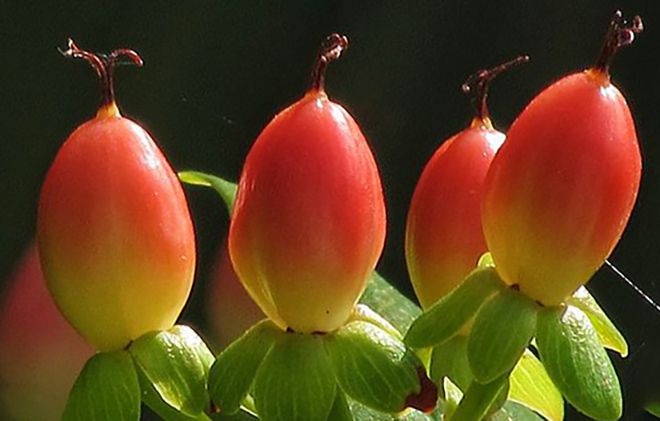

Growing St. John's wort in the garden
St. John's wort is not often grown in their garden plots. But in fact, the plant is completely unpretentious. A perennial plant perfectly accepts a variety of fertilizers. It is not whimsical to the soil, before planting St. John's wort, it is enough just to loosen the ground... For the best results, it is best to plant the plant before winter.
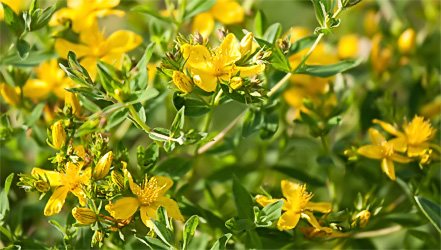

Plant in the garden
You need to plant the seeds in the soil to a depth of about one centimeter. Seeds are planted for the first time, at first they do not grow actively and slowly, therefore, it is necessary to regularly loosen between the rows, as well as get rid of weeds by removing them. When the plant grows up and begins to bloom, at this time you can cut the crop, around the end of June. It is necessary to carry out the insert manually with the help of garden shears. If we are talking about large plantations, you can resort to using a mower. In two months, closer to the beginning of autumn, the plant will grow up again and it can also be cut off. Thus, two harvests can be obtained in one season.
After cutting, the stems should be stored in a dark, dry place. When the plant becomes dry and brittle, the drying process is considered complete. You can store the crop in this form for a long time, about four years.


Drying the crop
A brief botanical description of St. John's wort
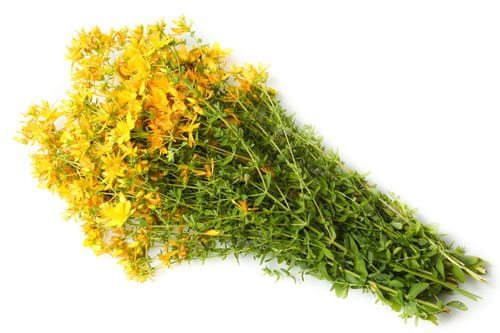

There are several varieties of St. John's wort. However, only two of them have medicinal properties: St. John's wort and St. John's wort. The differences between them are insignificant.
The first is a perennial herbaceous shrub. Its height reaches 1 meter. The grass has yellow, black speckled flowers and whole-edged oval leaves, located one opposite the other. There are usually several stems. They have a four-sided shape. After flowering, the fruit ripens in the form of a box, which, after ripening, bursts in several places and scatters the seeds.
Useful properties of St. John's wort
St. John's wort is widely used in the medical field. The plant is useful only for women, it is highly undesirable for men to use St. John's wort, it can cause problems with potency. In gynecology, various decoctions and infusions are usually used to treat breast diseases, as well as against inflammation of the vagina. The course of treatment is prescribed strictly by a specialist.
The plant is also useful for other areas:
The plant is an effective antidepressant
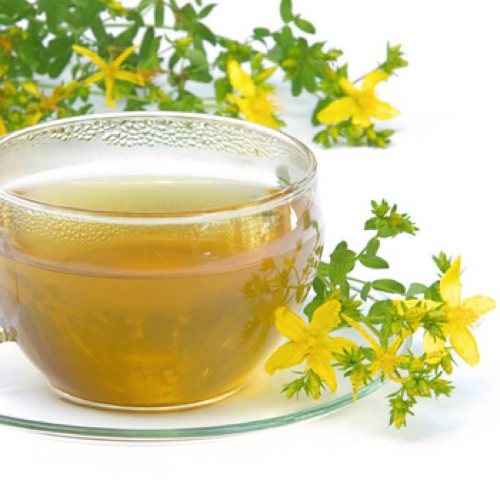

St. John's wort tea
Spotted
St. John's wort is a perennial erect plant, reaching a height of 30 cm to 70 cm. It differs from other subspecies in the presence of wide sepals and a stem with four protruding ribs.
The color of St. John's wort is most often brown, sometimes reddish. The flowers are small, no more than 2 cm, golden in color, located in the upper part of the plant and collected in a sparse inflorescence. In the process of ripening, a box with small seeds is formed.
This species is distributed throughout Europe, as well as in the southern regions of Siberia. It is most often found in dry tall-grass meadows, along the banks of rivers and lakes, along the roadsides. It has high medicinal properties and is used for medicinal purposes.
Important! Long-term use of St. John's wort preparations in men can cause temporary impotence.
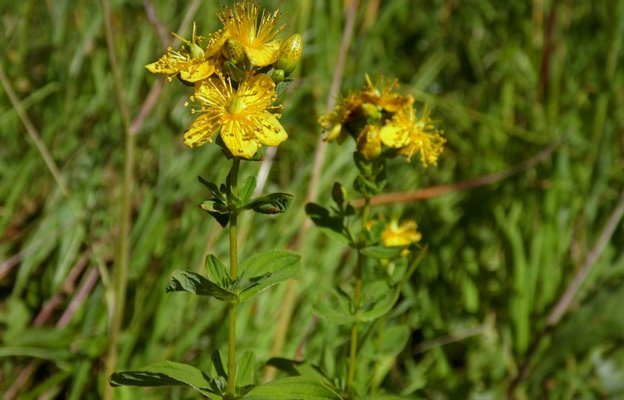

St. John's wort tea and St. John's wort decoction
For those who often suffer from colds, it is necessary to store dried St. John's wort at home.Tea using this plant is very useful, it will help restore weak immunity, and is also an excellent helper in the fight against colds. To enhance the beneficial properties of St. John's wort will help the addition of other medicinal herbs. To make tea from St. John's wort, pour boiling water over a dried plant, wait until the tea cools down to room temperature. Then you can use healthy tea.
Mountain
St. John's wort is found in deciduous forests, slopes overgrown with shrubs throughout the European part of Russia, Ukraine, Belarus and even in the Caucasus.
It is characterized by the presence of straight, simple stems, which can branch slightly and at the same time reach over half a meter. Leaves are oval, large from 5 cm to 6 cm, with a slight roughness below, usually located on the crown of the plant.
Flowers are yellow, collected in capitate inflorescences. It is used for both decorative and medicinal purposes.
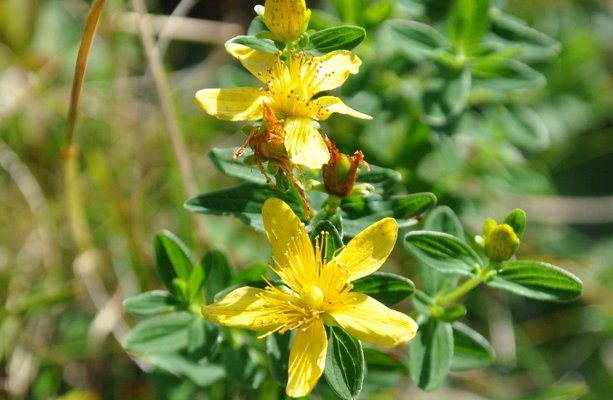

Did you know? In the Caucasus, an infusion of St. John's wort is used as a highly effective anthelmintic agent.
St. John's wort decoction
A decoction from the plant will become an assistant in the treatment of the cardiovascular system. This drink will relax you, it is better to use it at night. When you wake up in the morning, your condition will be much better. Also, such a decoction will help relieve sore throat, help cure sore throat. It is necessary to take a decoction for angina at room temperature in small sips.


Decoction of flowers
Large
St. John's wort is a herbaceous plant, over a meter in height. Its stems are erect, sometimes branching at the top. The leaves are oblong in shape, slightly pointed, on the back side they acquire a bluish tint, attached to the stem opposite each other.
During flowering, rather large yellow flowers appear, located singly or up to 5 pieces at the tips of stems or branches. The flowering period is short - from June to July.
It occurs naturally in pine and birch forests, among bushes, along rivers and lakes in Siberia and the Far East. Thanks to its rapid acclimatization, St. John's wort has spread to China, Japan, the United States and Canada.
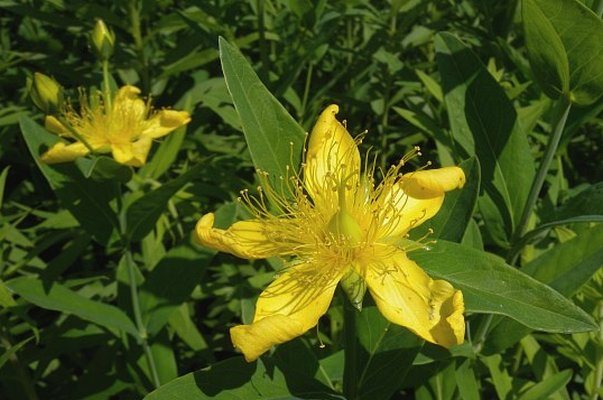

Contraindications to the use of St. John's wort
The use of St. John's wort is possible only after consulting a doctor. The plant has several contraindications. A few tips for using Miracle Plants:
- Cannot be used by pregnant women
- Do not brew too strong a tea from the plant, stomach pains can only worsen. It is necessary to brew one teaspoon of a dry plant per glass.
- While taking the plant, try to contact with the scorching sun as little as possible. The skin becomes sensitive, you can get sunburned in a couple of hours.
St. John's wort is not only a beautifully flowering plant, but also an excellent helper in the fight against many ailments
Pay attention to an interesting video on the topic:
Prostrate
St. John's wort is an annual ground cover, the stems of which branch out and reach a length of over 10 cm. But sometimes there are erect, rather branched glabrous plants that form turf trees up to 15 cm high.
The leaves are small, elongated, with a small thorn at the end. The flowers are also medium-sized, up to 1 cm in diameter, single or collected in small loose inflorescences. Petals are yellow, with black pinpoint glands.
It blooms all summer, but it is quite hygrophilous and does not tolerate shade. One of the advantages of this type is its high frost resistance. St. John's wort grows comfortably in Western and Central Europe in fields, meadows and arable lands.
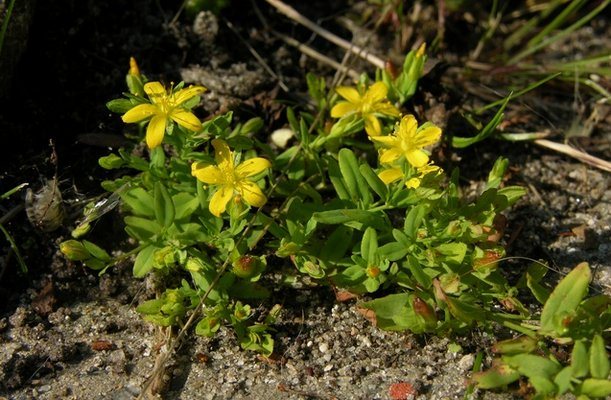

Wintering
Most species are highly resistant to frost. The plant tolerates winter easily. Wild bushes independently prepare for winter, but garden crops and hybrid varieties require preparation and high-quality autumn care.After the fruits appear, watering of the plant is gradually reduced. By the beginning of frost, watering is completely stopped.
In the fall, after the fruits are ripe, the apical part of the plant is completely cut off, leaving only 10 cm from the base of the soil. If wild bushes do not require shelter for the winter, then hybrid varieties must be insulated by covering the place of their growth with a layer of dry foliage or spruce branches. In this case, even if the winter was cold and with little snow, some bushes may freeze a little. However, in spring, with the onset of warmth, the bushes quickly restore the howling structure and greenery.
Bush care
Planting and caring for the ornamental shrub St. John's wort is simple. Do not allow overdrying of the soil and overgrowing with weeds.
Watering
Crops of St. John's wort are not afraid of heat, and they need to be watered only as the soil dries up. Overflowing water is not allowed. If possible, it is advisable to organize drip irrigation. An increase in watering is justified only in long dry weather, but even in this case, you should not flood the plantings, you just need to increase the frequency of watering. For better moisture penetration, it is necessary to loosen the soil in time and prevent weeds from overgrowing.
Top dressing
To obtain colorful and lush shrubs, there is no need to fertilize plantings during the season. If the soil was well prepared before sowing, then further you can limit yourself only to watering and weeding.
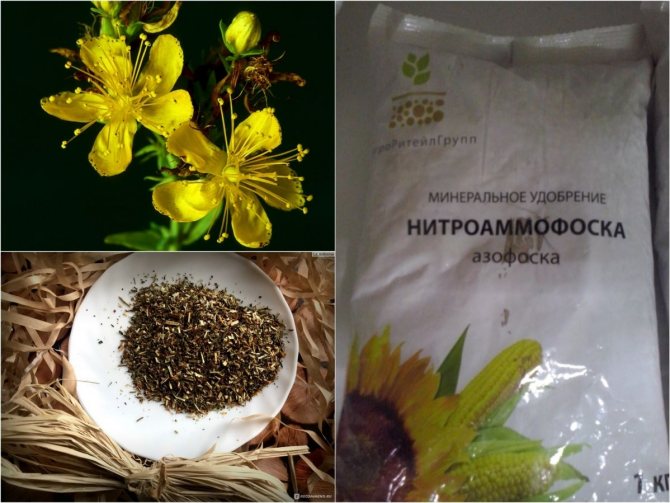

Photo: collage <>
But additional feeding can significantly affect the splendor of the flowering and the size of the buds. In addition, fertilizer elements help to increase immunity, and, as a result, plant resistance to pests and diseases. For fertilization, you can use a nitroammophoska. It is enough to make 800 g per hundred square meters.
It should be taken into account that the introduction of mineral fertilizers contributes to a richer flowering.
In wet soil, the granules will dissolve faster, and the beneficial elements will reach the plant roots. Starting from the second year of cultivation of the plantation of St. John's wort, this top dressing is mandatory, since the soil is depleted and the yield may decrease.
Pruning
St. John's wort bushes are recommended to be cut twice per season. During spring pruning, damaged, broken and frozen branches are cut out. This will not affect tillering. The bush will release fresh shoots very quickly. Autumn pruning involves removing lignified and damaged branches. The stems are shortened to prevent breakage under the weight of the snow. The exception is the bushes of ornamental varieties, which the gardener forms according to his idea. In this case, depending on the left height of the bush, you will have to take additional measures to preserve it, for example, cover it with boxes or build a shelter-hut.
Soil care and weeding
In the first year of cultivation, special attention should be paid to the timely weeding of plantings. The seedlings of the plant are very delicate, fragile, and wild weeds do not cost anything to drown them out. When the seedlings get stronger, the second wave of weeds will no longer be able to displace them, but will be able to interfere with full growth and productivity. Therefore, weeding should be regular throughout the season. You should not overdo it either, in order to avoid damage to the roots. It is advisable to leave the cut grass in place - firstly, it helps to preserve moisture, and secondly, by rotting, it will serve as an additional organic feeding.


Photo:
Spread
St. John's wort is a representative that lives mainly in places with a temperate climate. Certain species are found everywhere. Plants are also found in northern climates, but most species grow along the shores of the Mediterranean.
St. John's wort lives everywhere. You can meet wild crops along river banks, as well as in meadows and fields. It is cultivated in open areas, but the optimal habitat for St. John's wort is bright forest glades surrounded by spruce or pine forests.The plant does not form thickets, it lives in solitary, less often in two or three bushes.
Use in cooking
Dried crushed flowers and top leaves of a plant used as a condiment... This spice goes well with fish and meat dishes.
It gives them a piquant bitter taste and a bright balsamic aroma. It is used for the preparation of canned fish, vegetable salads, soups.
St. John's wort is often added to some wines, homemade liqueurs, tonic drinks, balms and bitters.
Fresh green leaves can be added to spring salads and snacks... Dried raw materials with the addition of strawberry and currant leaves are suitable for brewing invigorating tea.
How to grow St. John's wort on the site
Although St. John's wort is often found on the territory of our country, its natural reserves have significantly thinned out due to incorrect mass harvesting of the plant. Therefore, the owners of summer cottages can grow this medicinal herb right next to their home. First you need to collect the seeds of wild St. John's wort. This should be done in September, having previously determined the place of its growth.
Location. When choosing a site for growing St. John's wort, you should not take the best places for it, since it is unpretentious and can grow everywhere. Little-used places in the garden with good illumination are well suited for him, since this culture loves sunlight. You can plant it between the beds or along the garden paths.
The soil. The plant is shade-tolerant, grows on any well-drained garden soil, black soil and sandy soil. Negatively refers to clay, alumina, acidic and alkaline soils.
Top dressing. When growing St. John's wort and caring for it, it must be borne in mind that this perennial can significantly deplete the soil over several years of its growth and development, and this will affect both its decorative effect and yield. Therefore, the soil must be fertilized annually using organic matter or Nitroammofosk. The first top dressing is applied in early spring, and the second before the flowering of this culture.
During the flowering period, it is necessary to regularly loosen the soil in the area where this perennial grows, and regularly remove weeds.
Watering. Caring for St. John's wort includes watering, which should be moderate even in severe drought. With waterlogging, decay of rhizomes is noted. To avoid this, water the plant only when the topsoil dries out. During periods of heat and drought, the amount of watering can be increased.
Wintering. The culture is highly frost-resistant and usually tolerates cold winters with ease. If the winter is cold and little snow, the bushes may freeze a little. To avoid freezing, the plants are slightly covered with spruce branches. But if the plants are still frozen, the gardener should not worry, as this perennial quickly recovers.
Livestock and toxicity
St. John's wort is known worldwide for its toxicity to livestock (cattle), which can be encountered by a plant that grows like a weed in pasture. This is unlikely to threaten gardeners in their backyards, it would be remiss not to briefly mention this aspect of the plant. Some farmers have an interest in herbs, and it may be useful for them to know about this plant.
The active chemicals in St. John's wort reacts to sunlight through photosynthesis. Oxidation occurs due to chemicals ingested by animals at certain wavelengths of the sun.
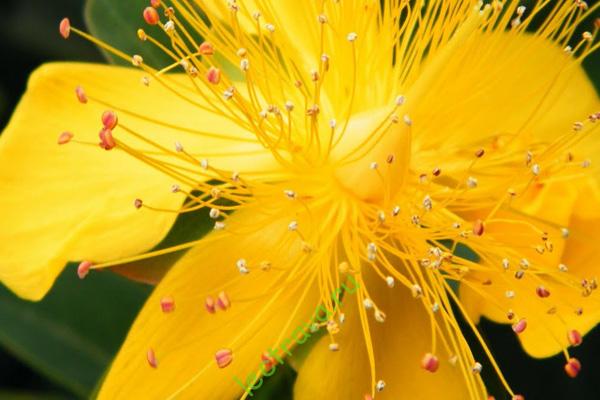

Poisoning symptoms of affected animals include skin inflammation, eye irritation and many other signs, which in turn can lead to serious liver damage.Other signs: Animals seek shade, mania and hyperactivity, frequent head shaking, digging, heavy breathing, confusion, hind limb weakness, increased breathing and increased heart rate, weight loss and poor growth in juveniles when breastfeeding.
It is necessary to remove animals from direct light and provide adequate nutrition. Typically, these guidelines help recovery if the damage is not severe. However, it is difficult for farmers to manage and track large numbers of animals, so many animals do not recover.
The use of plant-based medicinal products
There are many medicines in traditional medicine, the main ingredient of which is St. John's wort. The most popular ones are:
- Forest balm. A solution and paste based on this plant is used to strengthen the gums, as well as to prevent bleeding. Destroys harmful bacteria in the oral cavity.
- St. John's wort grass. It is used to treat gastritis, ulcerative colitis, stomatitis. On its basis, decoctions and teas are prepared.
- Depri forte. Promotes the normalization of sleep, has a calming effect on the body. Improves the functioning of the autonomic and central nervous system.
- Negrustin. It is an excellent preventive measure for the development of depression, improves the emotional state.
- Hypericum. It is used during periods of a depressive state. The effectiveness of the drug in neuroses and mental disorders is very high.


Important to remember! Before using medications, it is better to consult a specialist! He will select the most effective dosage for each individual case.
Care Tips
Having received a barely living rooted stalk by mail, she still went out and waited three years until she gained strength, it would bloom.
Where to plant? Better in a place protected from the north wind, in the sun or in partial shade. It is necessary. so that there is no flooding by groundwater, or to make drainage (expanded clay, broken glass, pebbles). The soil in my garden is loam, when planting, I put a handful of complex fertilizer, I did not add any other soil. Top covered with coniferous litter. St. John's wort loves acidified soil.
What is especially important
- The thing is. that every year above the snow cover the Headcoat freezes over. In the spring you can see it and you need to cut off the dead branches or cut their ends. You can safely cut the entire bush to a height of 10 cm, but only in the spring. Flowering occurs on new shoots. so pruning will only add decorative effect to subsequent growth.
- In the fall, so that the shrub does not lose strength, I only cut off the unripe shoots.
- A vital condition for the Headcoat in our middle lane is the hilling of the base of the bush in late autumn for the winter. I do it with coniferous litter to a height of 10-15 cm, you can use compost, spruce branches. Otherwise, we may lose rare beauty.
Do not be afraid. that St. John's wort hidcote will freeze, just pour a bucket of mulch on its base.
For better winter hardiness, you can feed it with a solution of potash, phosphorus fertilizer at the end of August September.
As you can see, there is no particular trouble with the Hypericum Hidcoat, but all the neighbors and connoisseurs will come to you to admire its beauty. I advise you to plant!
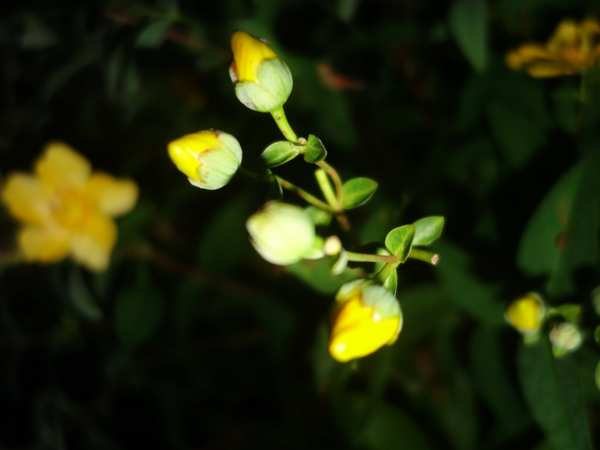

It is better not to prescribe St. John's wort from afar. and take a cutting from a friend or buy at a local nursery. Then there will be no problems with climate adaptation.
Cut in summer, when the twigs acquire some stiffness. Last year's shoots take root worse. It is not necessary to immediately plant it in the ground. can be put into water. Roots will appear in three weeks. It is even better to break off a small twig with a heel, tear off the lower leaves, plant it under a plastic shelter, after watering and compacting the ground. The degree of rooting is high.
The shrub grows in width slowly. so I do not advise you to multiply by dividing it into parts, there is a danger of ruining it.
I have no data on the medicinal properties of the Hidcoat, but I think that there are enough decorative ones. Plant and admire!
This entry was posted in Rare Plants by vsad.
[ad010]
St. John's wortdyadic, or dye
—Hypericum androsaemum
L
.
Caucasus, Asia Minor, Western Europe. Grows in forests, gorges, mountain slopes. Entomophilus, anemochore, irruptive, shade-tolerant mesophyte, mesotherm, mesotroph.
Semi-evergreen shrub up to 1.5 m tall. In GBS since 1962 1 sample (5 copies) grown from seeds of unknown origin. At 11 years old, height 1.1 m, crown diameter 115 cm. The plant grows from mid-April to mid-October. The growth rate is high. Blooms from mid-June to mid-July. Fruiting from 3 years old, the fruits ripen in late September and early October. Low winter hardiness. 100% of cuttings are rooted when treated with fiton. Not promising in central Russia.
Hypericum hookerianum
Photo of Kirill Tkachenko
St. John's wortHooker
—Hypericum hookerianum
Wight et Arn
.
East Asia.
Evergreen shrub up to 1 m tall.
Reproduction
There are several ways of growing and reproducing perennials of St. John's wort. If there is a desire, you can grow St. John's wort from seeds. In addition, if there is already a crop on the site that is more than 3 years old, you can get one or more bushes using young cuttings. Depending on the breeding method, different characteristics of planting the crop are taken into account.
Seeds
It is quite easy to propagate St. John's wort using seeds. The culture easily survives the winter, so fresh seedlings can simply be sown in previously dug soil. Sowing in the spring is carried out after the onset of heat. Before sowing, the soil is carefully dug up and mixed with humus, organic matter and peat. Sowing is carried out in holes, about 2 cm deep. If the planting was carried out in the fall, then the soil, after placing the seeds in it, is covered with a small layer of peat or dry foliage.
Propagation by cuttings
St. John's wort reproduces quite successfully in a vegetative way. If there is an adult bush in the garden or on the site, it is enough to separate small green twigs from it, on which there are several buds. Reproduction in this way is carried out in the spring, before the start of the active growing season. Several dense, high-quality cuttings are cut from the mother bush, which are then placed in a nutritious substrate. A sand-peat mixture, light soil is used as soil for the petioles. After placing the cuttings, the containers are covered with a film, creating greenhouse conditions for the plant. Finished greenhouses are placed in a warm, bright place. In order to prevent the plant from rotting, greenhouses are opened every day, and the soil is allowed to saturate with oxygen. These conditions remain until next spring. A year later, in the spring, the matured cuttings are transplanted to a permanent place of growth. Having provided high-quality care, you can see the flowering of St. John's wort next year.
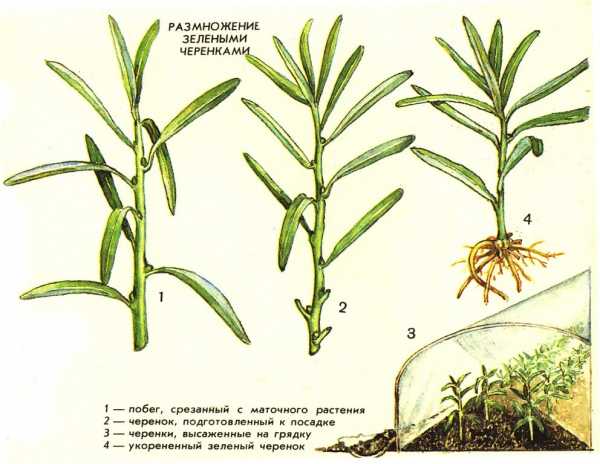

Rhizome division
Adult St. John's wort bushes can be propagated by dividing the bush. The mother is carefully removed from the ground in the spring and cleaned of excess soil. After that, the roots are carefully cut into equal parts, trying to leave a part of the central rhizome on both parts. The resulting bushes are planted in different places and provide them with constant care. After planting, the resulting and planted bushes are abundantly watered with organic fertilizer. St. John's wort is easily restored, therefore, in the same year, both bushes begin to bloom actively.
Application in decorating a garden plot
The use of wild plants to decorate a summer cottage garden is a modern trend in the field of landscape design. St. John's wort stands out for its long flowering and therefore looks effective in the garden, especially since the bushes can be pruned to decorate bouquets or use for medicinal purposes.
Usually, the crop is planted in an area close to the apiary, since the persistent aroma attracts bees well for pollination. The grass will harmoniously look in the beds with other medicinal herbs. The neighborhood is unpretentious, but planting near elite flowers should be avoided, the plant is too simple and takes nearby herbs similar in characteristics - chamomile, calendula, wild bells. The ideal solution would be to plant shrubs near the recreation area; on the hottest days, useful essential oils evaporate, which have a beneficial effect on the restoration of the nervous system and relieve fatigue. In our area, a perforated look is used for home gardening.
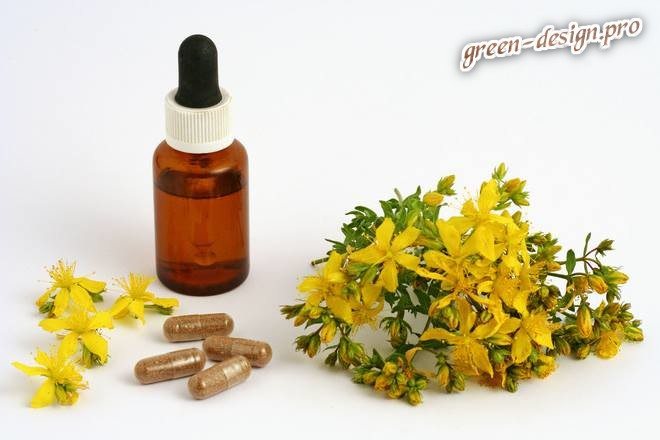

Headcoat in landscape design
Many gardeners, when shaping the landscape, focus on the ornamental shrubs of the Headcoat. They are used both in single plantings and to create compositions. From the bushes of St. John's wort, a decorative hedge with a height of about 1 m is obtained.
Landscape designers appreciate the Hydcot variety not only for abundant long flowering, but also for decorative leaves - from a distance they look like wax. The rich green color of the leaves of the bush goes well with bright yellow flowers. You can alternate between jasmine and St. John's wort - white and yellow flowers set off each other favorably.
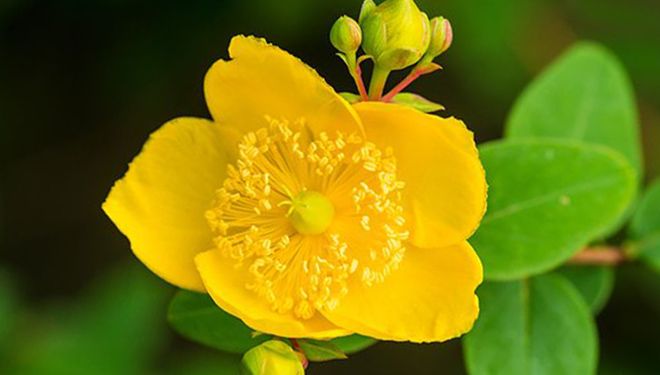

St. John's wort looks good in combination with perennials in rock gardens, stony, heather gardens. When creating a design in the Japanese style, flower beds are formed from bush crops, made in the form of a terrace. You can decorate rooftop gardens with St. John's wort.
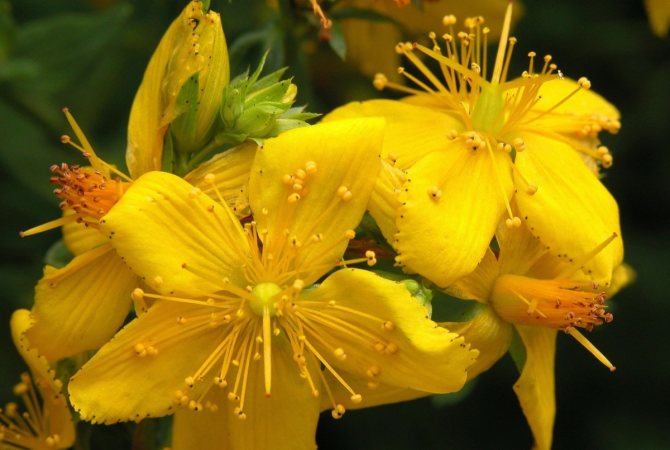

Modern gardeners, with all the abundance of varieties of flowers, often use decorative St. John's wort to decorate their plots. People search and find different types of this beautiful shrub. Its extraordinary unpretentiousness speaks in favor of this plant, it is distributed almost everywhere. Planting and caring for the ornamental shrub St. John's wort is not difficult. It does not grow only in permafrost. There are more than 400 varieties of it, there are also several species that are of exceptional interest to flower growers for their lush and long flowering.
Where are St. John's wort common
St. John's wort, or perforated (Hypericum perforatum L.) prefers a temperate climate and in the wild is most widespread in the Mediterranean, almost throughout the European part of Russia, in the Ukraine and the Caucasus, in Central Asia, Western Siberia, the Yenisei basin. He chooses dry and light forests, meadows, forest edges and meadows. It grows in very dry - in cracks of rocks, on stony placers, sands, in pine forests, bushes, savannah, these plants are common on pastures, fallow lands, along roads. Many species are found in the foothills and high in the mountains, entering the alpine belt. At the same time, St. John's wort is distinguished by a great plasticity of the external appearance, ranging from grasses to low trees.
It settles among shrubs, on fallow lands, on the outskirts of fields, often found in gardens and fields as a weed. St. John's wort does not like the northern and northeastern regions - he almost never occurs here.
In other words, it grows almost underfoot and in the wild, few people pay attention to it, remembering usually in those cases when it is necessary to make preparations of this herb for medicinal purposes.
It grows both singly and in groups of plants, but large thickets are not common. Prefers fresh felling and young clearings, where it can be found in bulk. The flowers of St. John's wort are very fond of bees, which get its pollen.
St. John's wort is a plant for your garden: growing, planting, care. Types of hypericum
The petals are the same number, equal to five, but in the decorative one they are rounded and accrete, a long pistil is surrounded by lace of stamens. You look, and once again you will be surprised how such a miracle was created by Mother Nature.
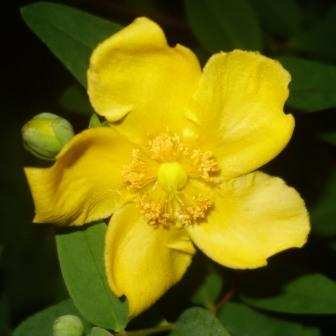

Headcoat
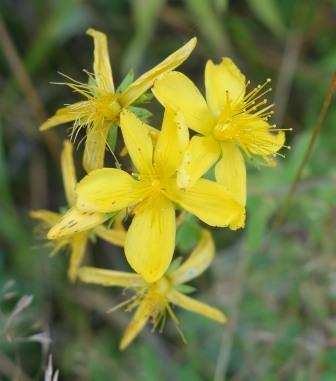

Perforated St. John's wort
I did not smell the flowers, but my friends felt a delicate pleasant aroma. But the leaves, if kneaded slightly in your hands, smell again of tenderness, I don't know. with what to compare.
It is now mid-September, the shrub is doing great, continuing to bloom, which will end in October.
As they bloom, wilted specimens should be removed, leaving only a few to form beautiful, red seed pods.
St. John's wort Hidcote hybrid. therefore, propagation by seeds does not make sense.
Landing rules
Planting and caring for St. John's wort does not require special skills. Even an inexperienced florist can cope with this. The plant reproduces well with cuttings. During landing, a certain sequence of actions must be followed:
- Purchased or cut cuttings should be placed in clean warm water for two weeks. During this time, roots should form on them.
- Petioles with a root system are transplanted into small pots filled with soil. Make up a soil of sand and peat, taken in identical proportions.
- In this state, subject to regular watering, the cuttings should spend the whole winter.
- Plants can be planted outdoors in spring. To do this, dig a small hole, at the bottom of which a layer of humus is poured.
- You should not bury the stalk deeply. It is enough to close the root system. Tamp the ground well and sprinkle with warm water.
If planting and caring for shrub St. John's wort is carried out correctly, then flowers will appear in the very first year. In order for them to winter normally, they must be covered with a non-woven material, for example, spunbond.
St. John's wort is an unpretentious plant. Caring for him consists in regular watering and weeding. In springtime it can be fed. Responds well to the introduction of nitrophoska in the first two years of growth.
Before wintering, the plant must be pruned. The entire aerial part is removed. The remaining necks are covered. For this, non-woven material, fallen leaves or dry grass are used.
As St. John's wort grows, it is necessary to remove dry leaves from it and cut off damaged branches. In rare cases, dark spots are found on the leaves. This indicates a rust fungus infection. The affected leaves are cut off and certainly burned. Even with good care, after three to five years, the plant loses its decorative effect, so the planting needs to be updated.
St. John's wort is an ornamental shrub with excellent decorative properties. It looks great on slopes or near a fence. With proper care, it will delight you with rapid flowering.
DECORATIVE ANIMALS
St. John's wort often suffers from unfair comparisons with medicinal species of this plant, the flowering of which is rather plain. But, not possessing the healing properties of medicinal St. John's wort, garden St. John's wort are just as hardy and surprisingly undemanding. These amazing perennials are able to surprise you with the beauty of greenery and inimitable flowering. In decorative compositions, they seem to be a scattering of shining stars, easily overshadowing even the favorites among flowering crops. The bright and inimitable textures of decorative St. John's wort deserve to be included in the list of the most versatile and attractive plants for the modern garden.
Immodest solar perennial (description of decorative St. John's wort)
In most cases, people who are far from passion for gardening and floriculture are familiar with St. John's wort as a medicinal plant that is actively used in both folk and official medicine. But those who have seen decorative types of St. John's wort at least once will never call them inconspicuous or boring.
The name St. John's wort from Greek translates as "near heather" ("hypo" and "ereike"), indicating that plants in nature are indeed often found in temperate climates and mountainous areas, living in the same environment with representatives of eric and heather.
In the genus St. John's wort there are both traditional herbaceous perennials of the rhizome type, as well as shrubs and even shrubs. Most of the decorative species are precisely perennial crops. All St. John's wort are characterized by branchy and spreading stems that form bushes similar to pillows. The leaves of these plants are whorled or opposite, whole, with an oval or ovoid, slightly elongated shape and a pointed tip. But the size of the leaves can range from 0.8-1 cm to almost 10 cm.
The flowers of St. John's wort are also different - both tiny and huge. But they are still always perceived as incredibly attractive and literally shine against the background of dark grassy greens. Yellow or golden, single or collected in few-flowered shields, panicles and half-umbels of inflorescences, flowers of decorative St. ... It is a pleasure to look at the fluffy decoration of flowers that are simple in shape, but by no means in their structure. They seem to be little suns, then stars and usually bloom tirelessly in such quantities that they produce the effect of a luxurious scattering on colorful fabrics. These beauties bloom from 30 to 55 days from the middle of summer.
After flowering in St. John's wort, leathery, cute unilocular capsules are tied, in which a lot of small seeds are hidden. The traditional fruiting month for all St. John's wort is September. Usually, even in regions with harsh winters, the fruits have time to fully ripen.
Growing conditions and planting
John's wort garden - easy-to-grow plants, which can be considered not demanding and quite hardy. They are suitable for both experienced summer residents and beginners.
To succeed with this crop, it is enough to choose open light areas and not too heavy, moist, well-worked soils for any hypericum. St. John's wort are undemanding to their composition and other characteristics. St. John's wort large and calyx-shaped are able to put up with penumbra, St. John's wort tolerates even light flooding and is grown in marsh zone of the reservoir
or at
coastal area
.
St. John's wort, regardless of the method of reproduction, tolerates any planting well and independently regulates the depth of immersion. This plant can be planted both in early spring and autumn. At the same time, abundant watering during planting and protection in drought from complete drying out of the soil is enough for adaptation and the beginning of rapid growth.
Care features
St. John's wort actually does not need any regular procedures, and caring for it is more than simple. This plant even gets rid of wilting flowers on its own, they do not spoil the look of the bushes and fall off quickly enough.
St. John's wort (species that belong to decorative) tolerate formation well and can be carried out if desired, creating a more strict silhouette.
If there is a strong heat or prolonged drought during the flowering period, then additional watering will have a beneficial effect on the duration and abundant color, but watering as such is not necessary for plants and are not necessary for St. John's wort. They are carried out only at will. Only St. John's wort is more demanding for watering and needs regular procedures.
The introduction of full mineral fertilizers in early spring stimulates abundant flowering, but in general, all St. John's wort are undemanding to soil fertility. St. John's wort will bloom even on rather poor soil.
St. John's wort, planting and caring for which can not be called anything other than simple, can rightfully be considered a plant that can be "planted and forgotten."
Hypericum wintering
St. John's wort, whose species have sufficient endurance for the middle lane, does not need protection for the winter and shelter. Mulching has a beneficial effect on the recovery rate of the bush in spring and the beauty of evergreen species. But even in the case of freezing, St. John's wort recovers very quickly.
Reproduction of St. John's wort garden
St. John's wort can be propagated both vegetatively and from seeds. For this plant, it is better to sow not for seedlings, but directly into open ground before winter, as soon as the temperature drops to 0 degrees, along with the rest of the perennials in need of stratification.
St. John's wort is propagated vegetatively: - by dividing bushes in early spring or autumn; - grafting with rooting under a hood in conditions of stable humidity; - layering.
It is difficult to find a plant that is easier to breed than St. John's wort. Reproduction with any method is quite effective, the plants develop rapidly and reach maximum decorativeness and the ability to bloom next year.
St. John's wort: species for planting in the garden
Hypericum (species related to ornamental plants) are very diverse and at the same time surprisingly similar to each other. First of all, these plants can be recognized by the combination of bright herbaceous greenery and dazzling yellow flowers, equal to the color of which can be found only among buttercups.
There are 300 plant species in the genus St. John's wort, most of the ornamental species come from Mediterranean countries. Active use in landscape design is typical only for some (less than 10) species of this plant.
Of large perennials, it enjoys the greatest love St. John's wort
(Hypericum ascyron) is a powerful plant up to 120 cm high with straight, tetrahedral shoots, branching only in the upper part. Elongated ovoid, oppositely sessile leaves seem to embrace the stem, they can reach 10 cm in length.Regular flowers with a double perianth consist of five petals (corrugated, with a wavy edge), reach 5 to 8 cm in diameter, often do not bloom singly, but 3-5 pieces at the ends of the shoots. The stamens are collected in 5 bunches, the upper ovary is very beautiful, five columns also grow together at the base. This St. John's wort blooms from July to the end of August. Today this species also includes Gebler's wort (Hypericum gebleri), which was previously considered separately, but is now sometimes sold under the old name.
A half-shrub grows up to half a meter in height St. John's wort
(Hypericum calycinum). This is a plant with evergreen elliptic-lanceolate leathery leaves and very large flowers, up to 8 cm in diameter, in the center of which are numerous stamens, often almost catching up with the flower itself. Bright, intense sunny yellow or lemon color makes this plant one of the most spectacular garden decorations.
Another type of decorative hypericum also belongs to dwarf shrubs - smany-leaved verba
(Hypericum polyphyllum), the height of which ranges from 15 to 35 cm.Densely leafy and branching shoots form a kind of semicircular pillows, against the dark background of the leaves of which five-centimeter dazzling yellow flowers with very wide obovate corolla petals flaunt. The center is relatively modest, but it is in perfect harmony with the massive flowers.
St. John's wort
(Hypericum olympicum) is a similar in height shrub with densely branching shoots and small, narrow and dark leaves, which create an excellent background for large five-centimeter flowers, collected in semi-umbellate inflorescences. St. John's wort blooming in the second half of summer conquers with slightly lowered, as if rejected corolla petals.
A much lower and rarer plant - St. John's wort
(Hypericum nummularioides). This is a dwarf species with a maximum height of about 15-20 cm, often even limited to 5 cm.St. John's wort of this species creates a beautiful rug of branches branching from the very base and woody from below, densely covered with small, not more than 1 cm in length, bluish leaves. The flowers are collected in semi-umbrellas, more nondescript than those of other species, but on such a miniature plant, they are still quite spectacular.
In the design of reservoirs, along the edge of ponds, to create various effects, creeping thickets and transitions in the design of water bodies, a stunted St. John's wort
(Hypericum elodes), which scientists around the world are arguing about today. It is a compact plant with a height of 20 to 30 cm, withstanding a five-centimeter flood. Creeping shoots form solid thickets, flaunt with pubescent rounded leaves and seem strikingly lacy. This St. John's wort blooms in cup-shaped small yellow flowers, noticeably inferior in beauty to ordinary garden species.
In regions with severe winters, it is much less common St. John's wort
... The only species that is able to survive the winter frosts of the middle lane is semi-evergreen
St. John's wort sprawling
(Hypericum patulum). It is a compact, but very beautiful shrub up to 1 m in height with strong branching of open, slightly drooping brown branches, as if spread out to the sides. A change in color from reddish or ruby in young shoots to dark brown adorns the plant during the time when it just wakes up in the spring. The leaves are large enough, up to 5 cm in length, ovate with a pointed tip, with a beautiful leathery, matte surface. The flowering of St. John's wort is as beautiful as that of any other St. John's wort. Large bright yellow flowers with long stamens creating an openwork center and a satin texture of the petals are collected in a few inflorescences at the ends of the shoots. Many call the sprawling St. John's wort the main competitor of the Potentilla, which is fashionable today. This plant continues to bloom for 2 months, after which poly-seeded leathery capsules ripen, cracking only next spring.
Use in garden decoration:
As a decorative deciduous and flowering plant in any flower beds and mixborders; - as a plant that effectively fills the soil between solo large crops; - in the design in a natural style, in groups and arrays; - in the role of single shrubs and perennials to decorate the lawn and meadows from ground cover; - to create undergrowth near bushes; - in the design of rockeries and rock gardens; - in compositions with a bet on the yellow palette; - in carpet mixborders; - for playing with a texture in a regular style; - in borders and for masking transitions and leading edges of decorative compositions
St. John's wort is suitable both for decorating rocky gardens, and for planting in a solo party or in various decorative ensembles.
Recently, many people are trying to replace traditional pills and injections with therapy with help. One of the most medicinal herbs is St. John's wort, which is increasingly grown. St. John's wort is unpretentious and even with minimal care it can give a good harvest.

